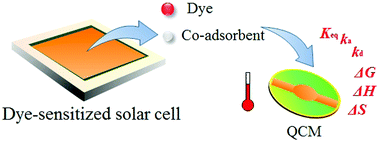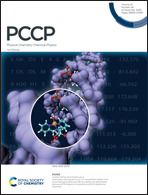A kinetic/thermodynamic study of transparent co-adsorbents and colored dye molecules in visible light based on microgravimetric quartz-crystal microbalance on porous TiO2 films for dye-sensitized solar cells
Abstract
In this study, a quartz crystal microbalance (QCM) in situ method is used to study the kinetic and thermodynamic processes of the adsorption of ruthenium-based dyes (N719, N3, N749), and the co-adsorbent chenodeoxycholic acid (CDCA) on the TiO2 film surface. The results of the kinetic studies show that the adsorption rate of N749 is slightly higher than the other two dyes, and the adsorption rate of CDCA is more sensitive to temperature change. The adsorption mechanism of the dye and CDCA on the surface of TiO2 can be reasonably inferred based on the result of the activation energy. The isotherm adsorption model studies show that the ratio of the number of surface molecules (296 K) is n(N719) : n(N3) : n(N749) : n(CDCA) = 0.69 : 1.48 : 0.50 : 1. The Keq value of CDCA is about two orders of magnitude smaller than that of all the dye molecules, which indicates that the adsorption strength of CDCA is much weaker than that of the dye molecules. Thermodynamic studies show that the adsorption reaction is an endothermic reaction. The ΔS is ΔS(N3 = 143.11 J mol−1) > ΔS(N719 = 112.72 J mol−1) > ΔS(N749 = 109.43 J mol−1) > ΔS(CDCA = 96.14 J mol−1). The Gibbs free energy ΔG is negative, and indicates that the adsorption reaction of the four molecules on the surface of the TiO2 film is spontaneous. The results of this paper show that the tedious and lengthy experimental process of the traditional method can be simplified by QCM. In addition, the development of this study provides a certain theoretical and experimental basis for future studies on the interaction mechanism between dyes and co-adsorbents.

- This article is part of the themed collection: 2020 PCCP HOT Articles


 Please wait while we load your content...
Please wait while we load your content...